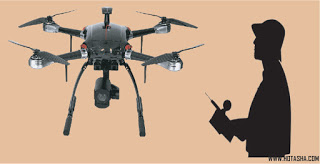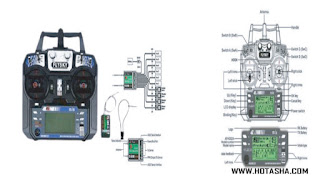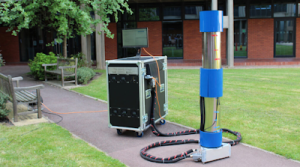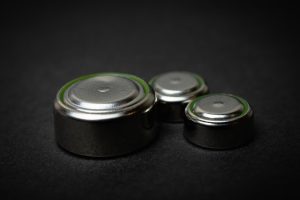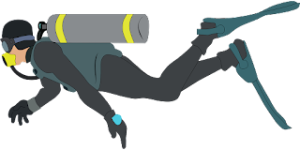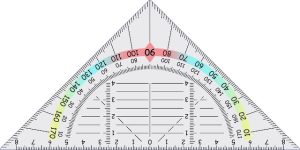Quadcopter is also called a quadrotor helicopter or quadrotor. It is a multirotor helicopter that is lifted and propelled by four rotors. These are classified as rotorcraft, as opposed to fixed-wing aircraft, because their lift is generated by a set of rotors.
Quadcopter Dynamics
A quadcopter model consists of a cross beam structure with 4 motors on each end and a collection of sets of electronic equipment. The 4 motor torques are the only inputs for a 6 degrees of freedom (DOF) system which define the quadcopter as an under actuated system. Without a controller to compensate for under actuation, there are 2 states that cannot be directly commanded. This, eventually, will cause a drift to undesired values over time. The motors are stationary and do not have any mechanical linkages to change the blade pitch. In that sense, the quadcopter utilizes a combination of the four motor torques to control all the states. The testbed is designed using the X-formation shown in Figure 1. One pair of propellers (Ω1 and Ω3) rotate clockwise (CW) while the other pair of propellers (Ω2 and Ω4) rotate counter-clockwise (CCW).
To command throttle, all four propellers must rotate at the same speed which provides a vertical force in the z-axis. If each propeller provides a quarter of the weight in thrust, the quadcopter will hover. Rolling motion is generated by either increasing or decreasing the torque in pair of motors on the left side (Ω3 and Ω4) while applying an opposite increase or decrease to the right pair of motors (Ω1 and Ω2). This produces a torque in the x-axis which creates the rolling motion. Pitching motion is generated by increasing/decreasing the front motors (Ω1 and Ω4) while applying the opposite action (increase/decrease) to the rear motors (Ω2 and Ω3). This combination produces a torque in the y-axis which creates a pitching motion. Yawing motion is generated by increasing/decreasing the CW motor pair while applying the opposite action (increase/decrease) to the CCW motor pair. This combination produces a torque in the z-axis which creates a yawing motion.
Equipment Details
APM (ArduPilot Mega) 2.8 Flight controller board
Ardupilot Mega (APM) is a professional quality IMU autopilot that is based on the Arduino Mega platform. This autopilot can control fixed-wing aircraft, multi-rotor helicopters, as well as traditional helicopters. It is a full autopilot capable for autonomous stabilisation, way-point based navigation and two way telemetry with Xbee wireless modules. Supporting 8 RC channels with 4 serial ports. ArduPilot Mega consists of the main processor board (red one above) and the IMU shield which fits above or below it (shown mounted together below).
Features: Point-and-click programming/configuration to get you up and operating without hassle .
Multiple command modes: Acro, Stabilize, Loiter, Alt-hold, Return To Launch point, Land, Simple, Guided, Position, Circle, Follow Me, GeoFence, and Auto (which runs fully scripted missions using GPS waypoints)
Failsafe programming options bring peace of mind in the event of lost control signal or low battery conditions.
Three Axis camera control and stabilization, shutter control, live video link with programmable on-screen-display
Data transceivers allow real-time telemetry and control between your ground station computer and APM, including joystick control options .
Full data logging provides comprehensive post mission analysis, with graphing and Google Earth mapping tools .
No dead ends — Advanced users will find endless options for customization and expanded mission capabilities.
As part of the 3DR Robotics Open UAV Platform, it’s easy to customize APM or develop new applications on top of it. Many compatible third-party applications, such as mobile apps and image processing tools, already exist.
Figure: APM (ArduPilot Mega) 2.8 Flight controller board
DJI F450 Quadcopter frame Kit
The frame is an important part of the aircraft because it needs to be light enough for the Quadcopter to take off but still strong enough to provide support and not break in a minor crash
Landing Gear Skid for DJI F450 F550 Frame
The ground clearance of this Landing Gear Skid is about 150mm which is too enough to mount gimbal and camera and also protect the camera and gimbal during the situation like a crash. It has an Weight of 90 grams.
A2212 1000KV Brushless Motor For Quadcopter
The motors chosen will have a huge impact on the flight time and how heavy of a load the Quadcopter can carry. It is highly recommended that the same type of motor be used for all of the rotors so that they all do the same amount of work for the Quadcopter.
There are multiple motors to choose from most of the Quadcopter motors are DC motors because gasoline motors are too heavy for the Quadcopter and a battery pack provides a DC current to make the DC motors the ideal choice. The key factor when looking for your motor is the KV rating. The KV rating of a motor relates how fast it will rotate for a given voltage. Most multirotor UAV’s a low KV is desired for stability like somewhere around 500 – 1000 KV.
If it is available it would be important to overserve the thrust rating that some manufacturers provide. Usually they will provide it with a given propeller options because depending on the propellers you get it will affect the total thrust you can achieve. This thrust is essential to your design because if your thrust is only 2.5 Kg and your Quadcopter weighs 2.5 Kg then it will have difficultly taking off and staying up. We have to choose the propellers and motors so that you can get the maximum thrust
30A Brushless Motor ESC( Electronic Speed Controller)
The ESC (Electronic Speed Controller) is what helps the flight controller to be able to control each of the motors separately. Using this device the flight controller can provide the correct amount of voltage at a time so that the entire Quadcopter can stay stabilized.
GPS Module Ublox NEO-7M With Electronic Compass for Apm
Ublox Neo 7M GPS module that includes an HMC5883L digital compass. The Ublox NEO 7 series is a high sensitivity, low power GPS module that has 56 channels and outputs precise position updates at 10Hz.
Receiver and Transmeter (FlySky FS-i6 2.4G 6CH AFHDS RC Transmitter With FS-iA6 Receiver)
Although it is possible for the flight contoller to control the Quadcopter autonomously it is generally a good idea to have a RC transmitter so that we can control the Quadcopter if something goes wrong or just use the RC transmitter instead so we can fly manually. In order to choose the best fit for a transmitter depends on how complex the Quadcopter is. Most of the time a handheld transmitter is adaquate enough but for larger areal vheicles it is better to have a base station to help with all of the controls.
Transmitters are judged based on how many channels they have. The number of channels a Transmitter has relates to the number of separate signals the transmitter can send. The more complex we make our Quadcopter the more channels we are going to need for the transmitter. Usually a 7 channel radio is adequate enough to operate most beginning Quadcopters
Battery
The battery should be based on the chosen motors for the Quadcopter. The battery pack’s capacity is measured in amp-hours(Ah) meaning that gives us how long we can last on the battery. But the higher the capacity the heavier the battery will be. The average flight time of a model Quadcopter is around 10 – 20 minutes on a 2-3Ah battery .
Propeller
1045 Nylon Propellers are used in this project. The diameter of props are given by the first number: 10×4.5 means 10″ diameter, 4.5″ pitch angle.
Power Module with XT60
The APM Power Module is a simple way of providing our APM with clean power from a LiPo battery as well as current consumption and battery voltage measurements, all through a 6-pos cable. The on-board switching regulator outputs 5.3V and a maximum of 2.25A from up to a 4S LiPo battery.
Specifications
- Max input voltage: 18V
- Max current sensing: 90A
- Voltage and current measurement configured for 5V ADC
6-pos DF13 cable plugs directly to APM 2.5’s ‘PM’ connector
Figure: APM Power Module with XT60
Other Apparatus
Required Softwar
APM Mission Planner 2.8. By this software, after perfectly calibration, we can make it final.
Connection Diagram
Procedure
A. For an assembled Quad with motors and ESC’s but no control or power board begin here:
- You need: Quad power distribution board, appropriate battery for your Quad, battery retention strap, 12 gauge wire, battery connector, four ½” nylon standoffs and necessary hardware.
- Solder The ESC power leads to the Power distribution board.
- Solder 12 gauge positive and negative battery wire leads to the power distribution board.
- Solder a battery connector correctly to the leads from the power distribution board.
- Mount the power distribution board on standoffs over the top center of the Quad.
- Attach the battery retention strap to the bottom of the Quad and install the battery.
B. For an assembled Quad with control and power distribution boards begin here :
- You need: APM2 flight control board and USB cable, 5+ channel receiver to use with your 2.4GHz transmitter, Five 3 wire servo leads with female connectors to connect your receiver to your APM2, an oversize plastic or fiberglass APM2 mounting plate with aluminum tape on the bottom, four 1.5” nylon standoffs and Velcro or double sided foam tape.
- Disconnect and remove any existing flight control board.
- Drill and mount the plastic mounting plate for the APM2 board in the center of the Quad over the power distribution board on 4 standoffs and aligned with the front of the Quad in your choice of X or + configuration. (X configuration has the front between 2 motors and + has a motor in front.)
- Using double sided shock absorbing tape or Velcro mount the APM2 board on to the fiberglass mounting plate aligned in the direction of travel (GPS to the back, SDI card toward the front).
- Retention can be improved by attaching a rubber band over the APM2 board.
- A clear (not black) plastic bowl cover over the APM2 board can reduce damage in a crash.
- Install your receiver onto the Quad with Velcro tape and with the antenna exposed externally.
- Install channels 1 – 5 servo leads to the receiver.
- Install channels 1 – 5 servo leads to the front connector on the APM2 board, Channel 1 is next to the white GPS connector. The white or yellow signal wire goes towards the center of the board. (Red and black wires on all but one connector can be clipped but this is generally not necessary since power and ground are common bussed at both the receiver and APM2 board.)
- Install The 4 ESC control leads on the connector at the back of the APM2 board with the white or yellow signal lead towards the center of the board.
- For X Quad frame configuration: a. The Front Right motor goes to the right most (first) connector position next to the LEDs. b. The Left Rear motor goes to the second connector position. c. The Front Left motor goes to the third connector position. d. The Rear Right motor goes to the fourth connector position.
- For + Quad frame configuration: a. The Right motor goes to the right most (first) connector position next to the LEDs. b. The Left motor goes to the second connector position. c. The Front motor goes to the third connector position. d. The Rear motor goes to the fourth connector position.
- The BEC plus (red) and ground (black) wires can be cut on all but one of the ESC control leads.
C. Install the Mission Planner program and Arducopter firmware and Set initial parameters:
- Your RC transmitter should initially be set up for a Quad as follows: a. Four primary channels are Aileron (roll), Elevator (pitch), Rudder (yaw) and Throttle. b. Channel 5 is set to a 3 position switch for in flight mode changing. c. All channels are set to plus and minus 100 percent servo travel range. d. Set the throttle, roll, pitch and yaw trims to zero. (May need to trim throttle down to arm). e. Some minus expo (-40%) is a good idea on the pitch and roll channels to start.
- Go to the ArduPilot website at http://code.google.com/p/ardupilot-mega/downloads/list and download the most recent “Mission Planner” and install it on your computer.
- Ensuring that the battery is NOT connected, start the “Mission Planner” and hook up your USB cable between your PC and the APM2.8 board.
- If you get a message indicating “New hardware found” select install driver when asked. If you are told “No driver found” you will need to load the driver from the Arducopter web site. Go to the Arducopter web site and in the search projects page search for “apm2.8code”. At the top of the list select the “APM2.8Code” item and then load the USB driver as instructed. You should get a confirming message indicating that the USB driver is installed.
- In the Mission Planner, ensure that on the top right of the screen that 115200 is selected for baud rate and the new driver Com (But not Com1, TCP or UDP) is selected. Fix if necessary.
- In the Mission Planner click on the Firmware tab then click on the Connect Icon at the top right of the Mission Planner screen to open the MavLink connection.
- It is possible you may still get an error indicating that your serial rate is too low. If you do you will need to open your PC’s Control Panel -> System -> Device Manager -> Hardware and set the 2650 Com device to 115200 baud. (Windows 7 has a different method for setting up the port.)
- Once connected; select the Firmware tab and Click on the bottom center “APM Setup” button.
- Turn on your transmitter with your Quad set up selected. (Mode 2 is shown, adapt for Mode 1).
- In the “Radio Calibration” menu, select “Calibrate Radio” and move the control sticks to all limits. a. Right stick Left (Roll Left) should equal low PWM. If not reverse the transmitter channel. b. Right stick Up (Pitch Forward) should equal low PWM. If not reverse transmitter channel. c. Left stick Down (Throttle Low) should equal low PWM. If not reverse transmitter channel. d. Left stick Left (Yaw Left) should equal low PWM. If not reverse the transmitter channel.
- Move the three position mode select switch to all 3 positions to calibrate it too.
- When you are done calibrating, select the “Finished” button at the bottom right of the screen.
- Select “Flight Modes” on the left side of the Mission Planner screen and set all 6 of the Flight Modes to “Stabilize”, uncheck all the “simple” mode boxes and click the “Save Modes” box.
- Now select “Hardware Options” and click on “Enable Compass”.
- Select the “Go to the Declination Web Site” box and retrieve your locations magnetic declination.
- Enter your home declination in the Declination window as described and hit the tab key to exit.
- Select “Arducopter Level” on the Mission planner left edge. With your Quad sitting very level, click on the “Level Arducopter” item then select the X or + Quad to set your frame orientation.
D. ESC calibration sets the ESC endpoints to be equal and is essential for correct operation.:
- There are 2 modes for adjusting ESC endpoints. Automatic adjusts ESCs all at once and is easiest. Manual individually adjusts each ESC. Try Automatic mode first then Manual if that fails.
- Automatic Setup (all ESCs at once) (Remove the Props and disconnect the USB cable). a. Turn on your transmitter and put the throttle full on then connect the Quads battery. b. When the APM2 boots the LEDs will cycle continuously. c. Disconnect the battery and then reconnect it initiating ESC calibration. d. Drop the throttle stick to the lowest position. There should be 1 or 2 confirming beeps and when you move the throttle up the motors should start and turn in sync. e. Disconnect the battery. The ESCs should now be calibrated.
- Manual ESC Calibrate (Each ESC calibrated individually). (Remove props and disconnect USB). a. With the battery not connected, plug the 3 wire plug of the ESC you wish to calibrate into the throttle channel of your RC receiver. b. Turn on your transmitter and put the throttle full on. c. Connect the battery and after you hear 2 beeps drop the throttle to full down, you should now hear 3 beeps and then a longer beep indicating the ESC is calibrated. d. Disconnect the battery then repeat the above for each ESC.
- Even after Manual calibration occasionally the ESCs will not initialize (continuous loud beeping). If this is the case try one additional automatic calibration.
- Normally if the ESCs are properly calibrated, when you power up the Quad and APM2 by plugging in the battery, there should be a slow ticking and the motors may “twitch” just a bit.
- Once you have the slow twitch / motor tick on battery connection, arm the motors by holding all the way down and to the right on the throttle for at least 4 seconds. The red LED should come on solid and the motors should respond to throttle and turn on at the same time in sync.
- Disarm by holding the throttle down and to the left for 4 seconds.
- If the APM2 board failed to arm set the throttle trim a few clicks lower and try again. The bottom throttle setting must be below zero to permit arming.
- Once armed, the motors should start at the same time and run at the same speed with only the throttle being moved. If not, you need to go through ESC calibration again.
E. Setting Prop Direction and checking the sensors for correct operation:
- A Quadcopter has two props turning clockwise and two turning counter clockwise which keeps it from inadvertently turning on its own axis, but permits it to turn (Yaw) when it is commanded to.
- You need 2 matched clockwise propellers usually marked R or P and 2 counter clockwise ones.
- The 2 clockwise propellers are opposite each other as are the 2 counter clockwise propellers.
- Without propellers installed, turn on your transmitter, plug in the battery and verify and correct each motor so it is turning in the direction as indicated below then install the propellers. Reverse any 2 of the ESCs 3 motor lead connections to reverse the direction of the motor.
- Disconnect the battery before installing propellers. The clockwise (usually marked R or P) or counter clockwise propeller should be installed on each motor with the printing on the front (top).
- For X configuration: (Check and correct motor directions before installing propellers) a. On Front Right and Back Left motors install counter clockwise propellers. b. On Front Left and Back Right motors install clockwise (R or P mark) propellers.
- For + configuration: (Check and correct motor directions before installing propellers) a. On Right and Left motors install counter clockwise (R or P mark) propellers. b. On Front and Back motors install clockwise propellers.
- With battery unplugged, connect a USB cable, start Mission Planner and select “Connect”. a. The heads up the flight display on the left will show the current altitude of your Quad. b. The compass display at the top will show the direction your Quad is facing. (If it is near metal objects or electronic devices it may cause a significant deviation). c. Unless you are outside with GPS lock it will NOT show your current GPS position. d. Tilt your Quad to various positions to see if the Heads up display follows your expectations also rotate about the center axis to make sure the compass display follows. e. When the Quad is tilted forward the green horizon should rise f. When the Quad is tilted to the left the green horizon should angle down to the left. g. This only verifies that the sensors are functioning properly, if the motors and propellors are hooked up properly, the Quad should be capable of flight, if they are not it will crash.
- Make sure that transmitter control directions match expected results. There are various methods that can be used to do this, but the one we have found to be most reasonable and successful is: a. On a calm day set the Quad outside facing away from you on a flat level spot with at least 20 feet of flat clear space in every direction. b. Turn on the transmitter and then plug in the Quad’s battery. c. Stand at least 10 feet behind the Quad and arm the APM2 by holding the throttle down and to the right for at least 4 seconds. (GPS lock is not important at this time). d. Slowly turn the throttle up until the motors just turn on (should all start simultaneously). e. Now advance the throttle till the Quad is not quite taking off or moving. f. Use the rudder (Yaw) stick to yaw left and right in place. If working correctly proceed. g. Now move the Elevator (Pitch) stick to pitch slightly forward and back. When the stick is moved forward (up) the Quad should try and tilt forward and try and move away from you. When the stick is moved down it should try and tilt and move towards you. h. Move the Aileron (Roll) stick to roll slightly right and left. When the stick is moved to the right the Quad should try and tilt and move to the right. When the stick is moved to the left it should try and tilt and move to the left. Fix any problems before proceeding.
F. First Flights. (Stabilize is the basic and startup mode and is necessary for arming):
- Try a short flight in Stabilize mode. Arm the APM2.8 by holding the throttle down and to the right for at least 4 seconds (Red LED solid). (GPS lock is not needed at this time).
- Advance the throttle till the Quad takes off. Hold altitude to 4 to 8 feet above the ground with the Throttle. Compensate for drift with the Pitch stick. Reduce throttle and land.
- If the Quad is very twitchy or has too much power: Disconnect the battery and connect the USB cable between the APM2 and your computer then start the Mission Planner and select Connect then select the Configuration tab and then the PID List item in the left column. Reduce the Pitch Angle “P” value.
- Repeat several times adding rotation correction with the Yaw stick and making short excursions.
- Gain considerable flight experience in “Stabilize” before undertaking the more advanced modes.
Output Result
Discussion
At first , the connections of the circuit diagram should be followed accordingly. While Calibrating the Quadcopter, ESC calibration should be checked properly. The propellers should be kept aside for safety reasons. For GPS fix in calibration process, the quadcopter should be placed in an open place to get satellite signal properly , for about 2-3 mins . If the motors are not getting equal speed, ESC and Power Distribution Board should be checked for errors. Besides, the Transmitter channel settings should also be checked properly
Written
Jeion Ahmed
Tasnim Ahmed
B.Sc. in EEE CUET
Abdullah Al Noman
Hafijur Rahman Alve


